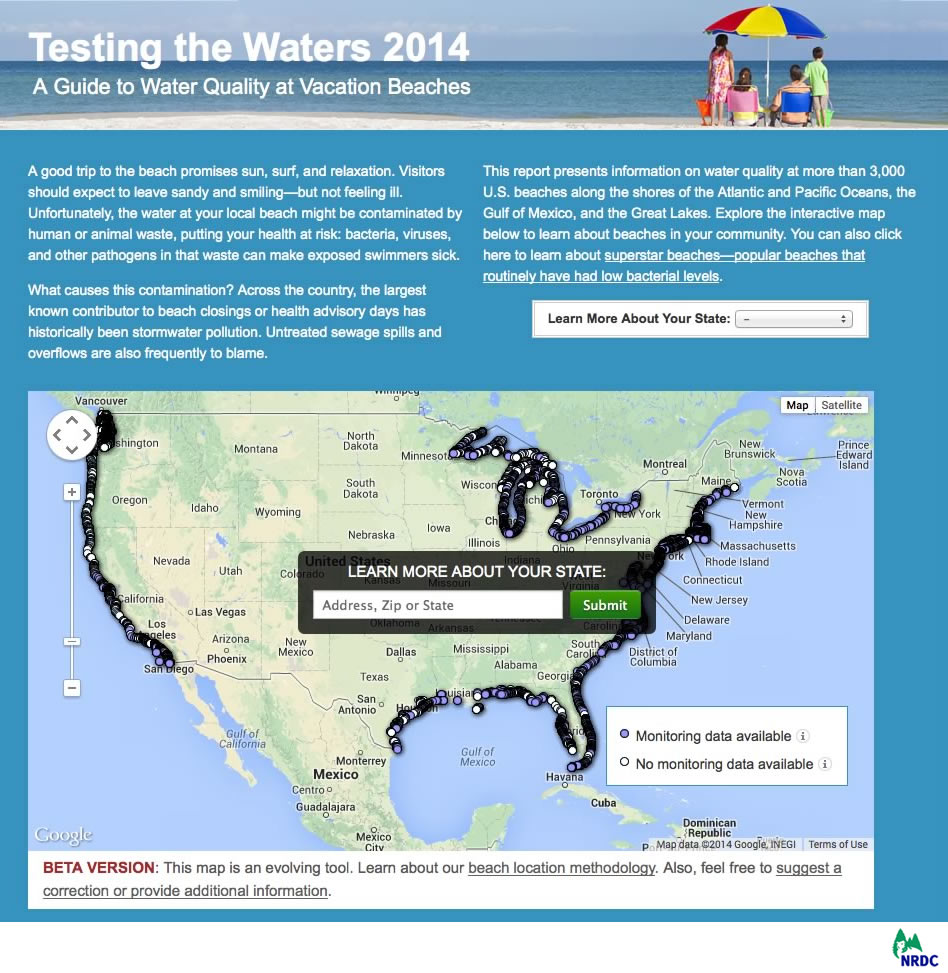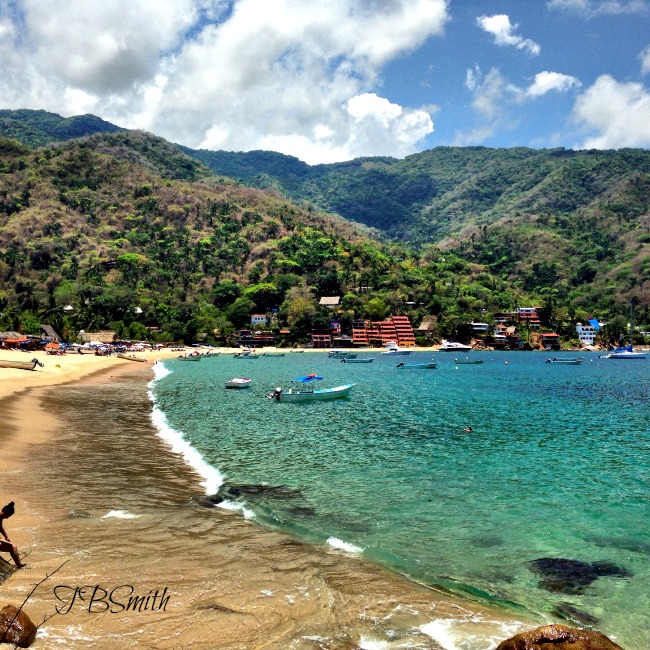In my previous blog post I wrote about the environmental education and awareness program that Puerto Vallarta’s Dolphin Discovery has in place for its guests. The dolphin trainers reiterate the importance of avoiding pollution in our oceans for the protection of marine life. But the message isn’t relevant just to ocean animals – it’s relevant to us all. Polluted waters and dirty beaches are bad for both animals and humans.
As Americans, we’re blessed to have a bounty of swimmable beaches throughout our country. Beach travel is a highlight for many families during the summer. The last thing any of us wants to worry about is exposure to a contaminated beach but water contamination is a reality and something that we have to keep on our radar.
What’s the source of beach contamination? Historically, massive storm water runoff and sewage overflows have been the largest known sources of the problem. Littering and other pollution also contribute to unhealthy beaches. Every year the National Resources Defense Council publishes a report on the status of America’s beaches.

Contamination Symptoms
“The EPA estimates that up to 3.5 million people become ill from contact with raw sewage from sanitary overflows each year. Beach water pollution nationwide causes a range of waterborne illnesses in swimmers including stomach flu, skin rashes, pinkeye, ear, nose and throat problems, dysentery, hepatitis, respiratory ailments, neurological disorders, and other serious health problems. For senior citizens, small children and people with weak immune systems, the results can even be fatal.”
This information is particularly valuable in our household.
Multiple sections of the nation’s beaches are tested for water quality by the EPA (Environmental Protection Agency). This year’s report found that 10 percent of beach water samples taken nationwide in 2013 failed to meet the most protective federal public health threshold used to assess water quality at American beaches – EPA’s newly created “Beach Action Value” (BAV).
Top “Dirty” Beaches
Based on the EPA’s BAV safety threshold, the Great Lakes region had the highest failure rate for clean beach water – 13 % of samples failed to pass the 2013 safety test.
Overall, 17 beaches were classified as “repeat offenders”, exhibiting chronic water pollution problems and failing to meet public health benchmarks more than 25% of the time each year from 2009 to 2013.
- California: Malibu Pier, 50 yards east of the pier, in Los Angeles County
- Indiana: Jeorse Park Beach in Lake County (both monitored sections):
- Lake Jeorse Park Beach I
- Lake Jeorse Park Beach II
- Massachusetts: Cockle Cove Creek in Barnstable County
- Maine: Goodies Beach in Knox County
- New Jersey: Beachwood Beach in Ocean County
- New York: Main Street Beach in Chautauqua County
- New York: Wright Park – East in Chautauqua County
- New York: Ontario Beach in Monroe County
- Ohio: Lakeshore Park in Ashtabula County
- Ohio: Arcadia Beach in Cuyahoga County
- Ohio: Euclid State Park in Cuyahoga County
- Ohio: Noble Beach in Cuyahoga County
- Ohio: Sims Beach in Cuyahoga County
- Ohio: Villa Angela State Park in Cuyahoga County
- Ohio: Edson Creek in Erie County
- Wisconsin: South Shore Beach in Milwaukee County
Safest Beaches

This year, the report found 35 popular “superstar” beaches with excellent water quality. The Delmarva region had the lowest failure rate, with only 4 percent of samples failing the safety test.
Each of the following beaches met national water quality benchmarks 98% of the time over the past five years:
- Alabama: Gulf Shores Public Beach in Baldwin County
- Alabama: Gulf State Park Pavilion in Baldwin County
- Alabama: Dauphin Island Public Beach
- California: Newport Beach in Orange County (1 of 3 monitored sections)
- Newport Beach – 38th Street
- Delaware: Dewey Beach-Swedes in Sussex County
- Florida: Bowman’s Beach in Lee County
- Florida: Coquina Beach South in Manatee County
- Florida: Fort Desoto North Beach in Pinellas County
- Georgia: Tybee Island North in Chatham County
- Hawaii: Hapuna Beach St. Rec. Area in Big Island
- Hawaii: Po’ipu Beach Park in Kauai
- Hawaii: Wailea Beach Park in Maui
- Massachusetts: Singing Beach in Essex County
- Maryland: Point Lookout State Park in St Mary’s County
- Maryland: Assateague State Park in Worcester County
- North Carolina: Ocean Pier at Main St. and Sunset Blvd. in Brunswick County
- North Carolina: Beach at Cape Hatteras Lighthouse in Dare County
- North Carolina: Ocean Pier at Salisbury Street in Wrightsville Beach in New Hanover
- North Carolina: Ocean Pier at Ocean Blvd. and Crews Ave. in Topsail Beach in Pender County
- New Hampshire: Hampton Beach State Park in Rockingham County
- New Hampshire: Wallis Sands Beach at Wallis Rd. in Rockingham County
- New Hampshire: Wallis Sands State Park in Rockingham County
- New Jersey: Washington (Margate) in Atlantic County
- New Jersey: 40th St. (Avalon) in Cape May County
- New Jersey: 40th St. (Sea Isle City) in Cape May County
- New Jersey: Stone Harbor at 96th St. in Cape May County
- New Jersey: Upper Township at Webster Rd. in Cape May County
- New Jersey: Wildwood Crest at Orchid in Cape May County
- New Jersey: Broadway (Pt. Pleasant Beach) in Ocean County
- New York: Long Beach City in Nassau County
- Virginia: Virginia Beach at 28th St. in Virginia Beach County
- Virginia: Virginia Beach at 45th St in Virginia Beach County
- Virginia: Back Bay Beach in Virginia Beach County
- Virginia: Virginia Beach – Little Island Beach North in Virginia Beach County
- Washington: Westhaven State Park, South Jetty in Grays Harbor
The best way to keep this pollution out of America’s beach water is to prevent it from the start – by investing in smarter, greener infrastructure on land, like porous pavement, green roofs, parks, roadside plantings and rain barrels. Let EPA know you support protecting streams and wetlands.
Check the full beach report and zip code searchable map: http://www.nrdc.org/beaches